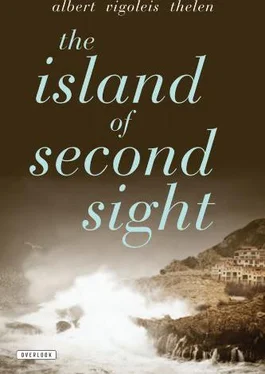In a word, from the tiny amount we saved by consuming the leftovers of saurian soup, we deducted a certain allotment for books. Language is feeble when it comes to expressing minuscule numbers; the diminutive of “an amount” is “a tiny amount,” and that’s the end of it. The Portuguese are better off in this respect. They can reduce a “tiny amount” ad infinitum, a skill that paradoxically can have a very grandiose effect. The formation of diminutives sheds a great deal of light on a language — a phenomenon that has been largely overlooked by the philologists. A Lusitanian citizen cannot buy a loaf of bread for 1000 reis, nor can he buy a book for 20,000. Our own tiny amount was situated so far below the borderline of diminution that we would have to buy a table and a chair not just second-hand but fourth- or maybe even tenth-hand.
Pedro knew of a rummage dealer on the Rambla, located below ground, a kind of catacomb of junk that, among other things, offered for sale vegetables and live poultry, rabbits, wine, crockery, and brushes.
Every country has its own morality as regards taxation, an attitude that gives rise to tax laws that invite secret and open fraud. Just as government ministries commit fiscal mayhem by means of bills pushed through the legislature, the individual citizen sets traps for the internal revenue office. Every more or less civilized country is familiar with this type of guerilla warfare. In Spain, store owners had to pay a store owner’s tax, no matter what, how much, or how little they sold. For this reason, all store owners sold everything: the butcher sold vegetables and alpargatas ; the greengrocer sold firewood, underwear, holy pictures, and bread; the coal dealer repaired shoes; the cobbler made bombs in his spare time; in the brothels, besides girls you could consult the latest newspapers. In Palma we bought the best nougat in a bookshop, where you could also lease a donkey. Besides tending to churches, the clergy was known for maintaining bordellos, bullfight arenas, and railroads. Thus it was no surprise to me when, arriving at this junk dealer’s premises, I saw fresh fruit, small animals, and brooms for sale. A quail was wildly whirling around in a small cage. Quail stands in high regard in Palma. Some say that it brings good luck; others tame the bird as a lure for catching other quails. Their meat is also prized. Mamú’s cook roasted them on a spit, and this was my favorite way of cooking them.
“ Duck-duck-duck, duck-duck-duck ,” said the bird in oddly onomatopoetic fashion, as I ducked down to enter the basement store. Even so, I hit my head against a crocodile that was fastened above the door. I took this as a good omen, and clapped my hands.
An old lady weaving straw in the doorway told me that if I was looking for Doña Carmen, I would find her down in the gallery. I should go right in, she said, but warned me that the monster over the door, though quite dead, could still be dangerous.
So even before descending to the depths, I knew the identity of the person who would sell me my junk. When dealing with a bureaucracy, it’s best to know beforehand the name of some clerk to look for. Yet on this occasion I placed greater trust in the song of the quail than in the revelation of the name Carmen.
I clapped my hands, and was already inside the store. It was suddenly darker in front of me, and it took me a while to adjust my eyes to the twilight. It was only after my third palmada that I heard a female voice in the background asking who I was and what I had come for. “Vigoleis,” I announced. “I’ve come to see Carmen.” I was told to wait patiently for just a moment.
The sum at my disposal was 12.50 pesetas; I wanted to buy a table and two chairs. I wasn’t prepared to haggle — I’m too proud and too stupid for such things, just as the old German proverb says: pride and stupidity were cast in the same mold. The objects I could make out in the darkness all looked more expensive than 12.50. A mahogany armoire, for example, was a cabinet-maker’s masterpiece, and must have belonged to a Sureda. It couldn’t have crossed the threshold for less than 1000 pesetas.
Doña Carmen had a large selection of all kinds of goods. There were cheap reproductions hanging on the wall next to genuine oil paintings that were, in turn, obvious forgeries. Potted palms rose up in royal splendor toward the ceiling, one of them set at an angle because it was obviously meant for higher surroundings. Old porcelain, clasps and brooches from the Bronze Age, green glass beakers, revolving coat racks, doorway transoms with cute painted Rococo scenes, stuffed armadillos — still plentiful on the island — votive altar pieces, gaming tables covered in green felt, walrus teeth with scrimshaw carvings, mirrors, the first typewriter ever manufactured, more mirrors, clocks, suits of armor, buckets, easy chairs, chests and pilarières , candelabras, porcelain cherubs, bird cages, eyeglasses, gems, a stork’s nest, an electric generator, and a prayer book. Absolutely everything under the sun was here, including its opposite, its supplement, its pendant, the reverse of itself. Certain items were available only in partial form; it was as if each part, once separated from its former whole, was yearning for a new completeness. What is the opposite of a sewing machine? I don’t know, but Doña Carmen would not only know, she’d actually have it in stock — perhaps not a vista , but she would drag it out from under an upside-down tin bathtub or a top-hat box. And she had a thousand other useful items — rats, for example. Three of them, if I counted correctly in the dark.
And besides, she had herself, the Queen of her own realm.
The fact that her name was Carmen is not particularly significant. Most Spanish women go by the name of Carmen, unless they were lifted out of the baptismal font as Dolores, María de los Dolores (“Mary of the Sorrows”), or Pilar — Our Lady of the Pillar. These are extremely popular names, though not as common as one finds in books about Spain whose authors, engaging in excusable exaggeration, attempt to be more precisely Spanish than the Spaniards themselves.
Doña Carmen was a voluptuous woman whose appearance could still knock a man’s socks off. I say “still,” because she was majestically approaching sixty. Zounds! Just imagine yourself thirty years earlier descending into this catacomb to meet her, to the accompaniment of that quail’s song: Oh my Carmen, my Carmencita, Carmencitiña, Carmencitilla, Carmencitititilla! I would have diminutized you down to everlasting sin on that Louis Seize canapé beneath that balding stuffed sloth! But this giant doll of a woman just stood there with her pompous dangling bosom and did nothing to conceal her age. As far as I could tell in the dim light of her shop, she hadn’t even made up her classic Carmen countenance. She didn’t need to, for she was a personality who spent her life amid the changeless conditions of life. On her brow, however, she wore the familiar curl, the upside-down question mark that is still used in Spanish typography and that facilitates the comprehension of complex sentences. When you see it at the beginning of a statement you know that the whole thing will be called into question. Was this the case with Doña Carmen, too? She wore a black silk albornoz with roses pinned on it, an adornment so attractive you felt like stealing it, or at least buying it outright — a practice that is by no means unusual in businesses like hers. The customer comes first — and in this case thirty years too late! But still early enough for a table and a couple of chairs. At this time of day, maybe even a bit too early.
I stepped forward out of the sunlit doorway and headed through the piles of assorted stuff to approach the shopkeeper. I made a bow, told her that I was pleased to make her acquaintance, and that her bazaar had been warmly recommended to me.
Читать дальше












